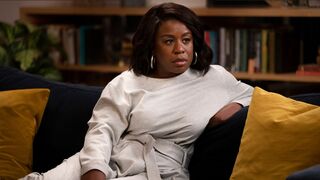Media
The 'In Treatment' Star Makes Plus Sizes Stunning and Enviable
How the well-dressed clinician helps represent what most women really look like.
Posted June 28, 2021 Reviewed by Davia Sills
Key points
- Fashion has a narrow view of what a woman's body looks like, with a size 10 or 12 being considered large.
- Television shows like 'In Treatment' are rare celebrations of the beauty of real-world women's bodies.
- Hopefully, popular media like 'In Treatment' can help bring greater awareness and fashion accessibility for women of all sizes and shapes.

Changing the portrayal of fashion on TV
The fourth season of the HBO series “In Treatment” focuses on the intense, erudite, complicated, complex, and emotionally charged language between a therapist and her patients. As Dr. Brooke, the therapist, Uzo Aduba is riveting. As a fashion icon, she is riveting as well. As a viewer who spent most of the pandemic year wearing clothes not too much different from those of a middle schooler, I envy, as well as admire, the innovative and beautiful clothes featured in every episode.
But it is not just the clothes themselves that capture the attention. They would, of course, even if they were on a mannequin in a store window or in a fashion magazine. It is the body wearing the clothes that is also captivating.
Finally, the clothes are being worn by someone who is not a size zero, with legs the length of a giraffe and without any obvious feminine parts, such as hips. Ms. Aduba has a well-proportioned female body, and her clothes emphasize rather than conceal it. And the fact that she is, by medical standards, probably overweight or obese does not diminish her stunning appearance.
When, if ever, has the star of an ongoing television series been both considerably overweight and a fashion icon? When have we seen clothes that reveal (and not conceal) the body of someone who does not conform to the fashion industry’s ideal of a perfect figure? One reason the clothes worn by the psychologist are so compelling is that they are so perfect for her full figure and so inappropriate for the skinny body of today’s typical model.
Is it possible that this show will achieve something unthinkable in the fashion world: make us appreciate and praise the beauty of a woman’s body, rather than the body of a woman that resembles that of a prepubescent girl?
Size bias in fashion
For decades, the fashion industry has ignored (and indeed scorned) the bodies of women who do not conform to their ideas of the ideal figure. A “large size” was 10 or maybe 12. A friend, who has not been a size 12 since before she was 12 years old, complained that she doesn’t shop for clothes in department stores because the stores don’t carry clothes in sizes greater than 12. All her clothes are ordered online.
Her perception is confirmed in a recent article in Style. According to the piece by Elizabeth Huber, many of the popular clothing brands do not manufacture women’s clothing for the 67 percent of women in the U.S. who wear size 16 and above. She goes on to say that the manufacturers who do make plus sizes often simply alter a smaller size style by making the hemline longer, the silhouette less fitted, or the sleeves shorter. Developing styles to flatter the larger figures is not their objective.
Moreover, the clothes may cost more than a comparable item in a smaller size. Christina Binkley discussed the current debate in the clothing industry over charging more for plus sizes. She refers to a New York designer who adds 100 dollars to the cost of a dress in plus size or a national company that charges more for large sizes in women’s but not in men’s clothing.
Faced with the increased cost and disappointing choices of off-the-rack clothes, women who can afford to do so are having their clothes custom-made. Doing so increases the possibility that the clothes will conform to their bodies and flatter, rather than conceal, their contours. One suspects that the clothes worn on In Treatment were custom-made for Uzo Aduba and probably financially out of reach for most women, no matter their size.
However, one hopes that actors like Ms. Aduba and others who are obviously not a size 2 will become commonplace in the media, movies, and television. Currently, even though overweight and/or obese women now comprise such a large component of our population, they are underrepresented in the movies, television, and print. One is most likely to see someone who is clearly more than a size 10 only on television advertisements for diabetes or high blood pressure. Rarely do they appear behind a desk or in front of a weather map on local or national news programs. The only programs that consistently have actors who look like they could be the size of one’s neighbors are foreign-made, such as programs that come from the BBC. In these programs, size (and hairstyles) seem irrelevant, and the actors don’t look as if they have gone through body sculpting or spend all their free time with their personal trainer.
Will In Treatment immediately alter the clothing market for plus-size women? Unlikely. There has to be a significant shift from selling plus-size clothes online, where presumably they are out of sight of the thinner customers. One hopes, however, that the fashion industry acknowledges how beautiful Ms. Aduba is in her clothes, and that becomes a catalyst for bringing beautiful, wearable clothes to the more than two-thirds of the female population who wants to wear them.


